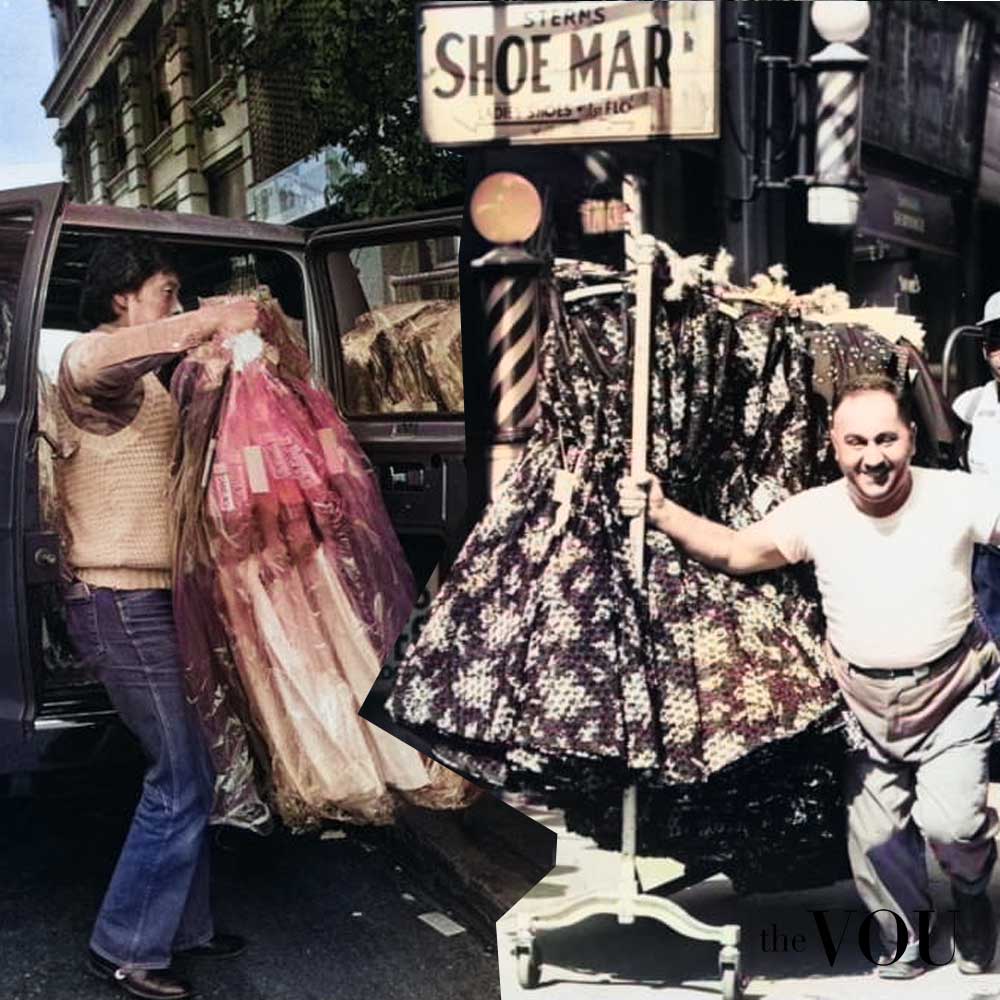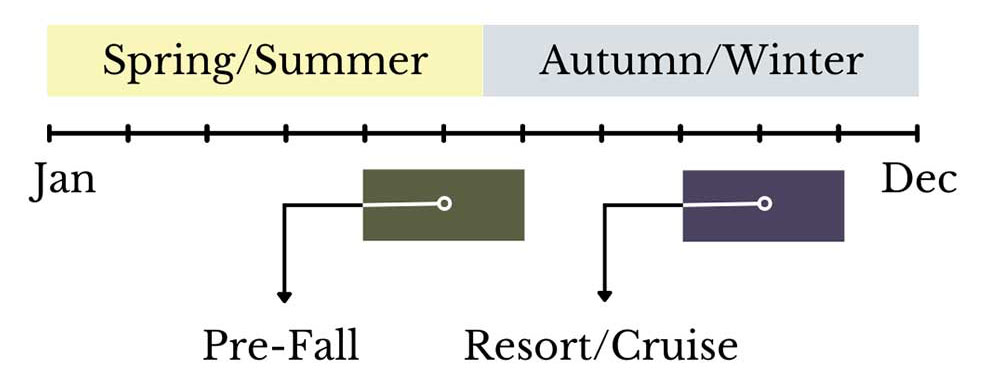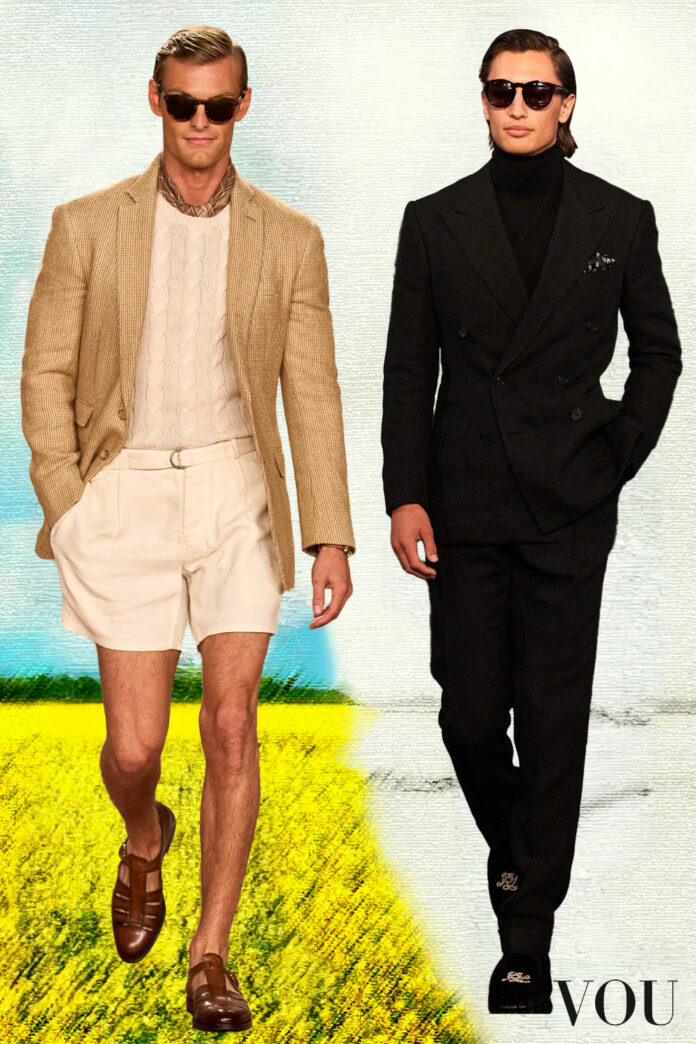Quick Answer:
A Fashion Season represents specific timeframes within the year when fashion houses present their new collections. The fashion industry operates on a bi-annual cycle with two main seasons: Spring/Summer (January to June) and Autumn/Winter (July to December). Additional micro-seasons include Pre-Fall (May-June) and Resort/Cruise (October-November). These seasonal cycles orchestrate the rhythm of design, manufacturing, and retail operations whilst serving as a framework for creative expression and market economics through advertising.
Key Points to Remember:
- Fashion Seasons shape designers’ collections, market responses, and consumer wearing habits
- Each season influences colour schemes, aesthetics, patterns, materials, and silhouettes
- The system evolved from climate-based needs to a global event schedule
- Seasons act as cultural signifiers beyond temporal designations
Want to learn more? Continue reading the full article below ↓
The term “Fashion Season” encompasses a unique blend of industry and market dynamics such as fashion design, trends, consumer behaviour, and retail.
In this article, we’ll unravel the concept of Fashion Seasons and its several dimensions: historical roots, impact on fashion design and styling, trends, aesthetics, and fashion industry role.
What is a Fashion Season?
‘Fashion Season’ is a term used in the fashion industry to describe specific timeframes within a year during which fashion designers and houses present their new collections in anticipation of the market.
The logic behind the fashion season is to create a structure for creative expression – allowing fashion designers and fashion houses to express their cultural aesthetics – and market economics through advertising.
As such, the fashion season sets the stage for fashion designers to unveil their latest trends while providing retailers with cues for inventory planning.
Each fashion season serves as a cultural barometer, reflecting the current fashion subcultures and influencing the prevailing social, political, and even environmental sentiments of the time.
Therefore, the fashion season is a temporal framework that simultaneously orchestrates the rhythm of fashion design, manufacturing, and retail operations and consumers.
Origin of Fashion Seasons
Since its inception, the concept of “Fashion Season” has undergone numerous metamorphoses.
Initially tethered to climatic needs and the natural world, the idea of Fashion Season evolved into a global event dictated by the world’s biggest fashion weeks and rigorous timetable.
The shift to a finely-tuned sartorial calendar encapsulates societal norm changes, technological innovations, and global capitalism.
A pivotal moment in the history of the Fashion Season was the advent of haute couture in 19th-century Paris, which established the city as a leading fashion capital of the world.
Another critical moment was the rise of ready-to-wear fashion in the 20th century, showcasing the need for a system that connects creators, designers, image consultants, stylists, and consumers.

Since the end of the millennium, seasons like “Spring/Summer” or “Autumn/Winter” are no longer temporal designations but cultural signifiers, behavioural codes, and consumer expectations.
The so-called “seasons” inform the current colour schemes, aesthetics, patterns, material selections, and silhouettes designers adopt to manifest their visions.
The contemporary Fashion Season provides the thematic framework within which designers exercise creative liberties, utilizing motifs, aesthetics, colour palettes, forms, silhouettes, and fabrics that resonate with a season’s conceptual underpinning.
For instance, a Spring/Summer collection may evoke an idyllic Bohemian style through floral prints and ethereal silhouettes.
In contrast, Autumn/Winter lines might depict the gravitas of an Old Money style, such as the American Ivy League or British Sloane Ranger, through darker, natural colours and weightier materials.
What Are the Main Fashion Seasons?
According to how the fashion industry operates, the Fashion Season has a bi-annual cycle split into releases:
- Spring/Summer, starting in January and ending in June.
- Autumn/Winter, beginning in July and ending in December.

However, with the advent of fast fashion and globalization, new pseudo or micro-seasons have emerged, such as Pre-Fall (running in May and June), Resort/Cruise (October and November), and capsule collections that help create a more versatile wardrobe.
What is the Role of Fashion Seasons?
The Fashion Season system serves as an economic lever within the global fashion ecosystem, influencing everything from sustainable fashion practices to slow fashion movements.
Through its cyclical nature, the fashion season shapes how designers conceive their collections, how markets respond, and what one wears.
This includes considerations for seasonal style adaptations and styling choices based on occasions and seasons.
The orchestrated cycles of collection releases, fashion weeks, and retail schedules significantly influence consumer spending, production timelines, and even textile manufacturing processes.
These cycles also impact how fashion trendsetters influence the industry.
Season-specific fashion trends dictate market demand, shaping fashion houses’ and retailers’ production and distribution strategies.
This seasonal rhythm has given rise to various interpretations, from avant-garde fashion expressions to more classic style approaches.
Understanding this economic machinery is paramount, for it fuels the cyclical nature of fashion, perpetuating the sartorial landscape’s dynamism.
The seasonal system has also influenced the development of distinct fashion silhouettes and aesthetic styles that define each period.
Fashion Seasons’ Impact on the Global Market
The fashion season system has evolved to accommodate modern demands, including the rise of streetwear and the influence of retro style in fashion.
This evolution has created a more complex landscape where traditional clothing concepts merge with contemporary trends.
Designers must now consider how their collections translate across various fashion accessories and complete outfits, ensuring cohesion throughout the season.
This has led to a more sophisticated approach to garment development and styling.
Conclusion
The concept of a “Fashion Season” has a multi-faceted nature covering the fashion industry’s creative, cultural, and economic sides.
As the industry continues to evolve, we see the emergence of new approaches to seasonal fashion, from personal style development to bespoke fashion solutions.
The Fashion Season acts as temporal parameters and conceptual space for fashion designers and consumers to engage, shaping the future of fashion as we know it.
Sources
Peer-Reviewed Articles:
- Davis, Fred. “Do Clothes Speak? What Makes Them Fashion?” Fashion Theory, vol. 5, no. 3, 2001, pp. 385-407.
- Entwistle, Joanne. “The Aesthetic Economy of Fashion: Markets and Value in Clothing and Modelling.” Fashion Theory, vol. 13, no. 2, 2009, pp. 271-286.
- Kawamura, Yuniya. “Fashion-ology: An Introduction to Fashion Studies.” Fashion Theory, vol. 8, no. 2, 2004, pp. 191–213.
Canonical Texts in Fashion Theory and Aesthetic Studies:
- Barthes, Roland. The Fashion System. Hill and Wang, 1983.
- Wilson, Elizabeth. Adorned in Dreams: Fashion and Modernity. I.B. Tauris, 1985.
- Simmel, Georg. “Fashion.” International Quarterly, vol. 10, no. 1, 1904, pp. 130-155.
The VOU Men's Styling Newsletter
Gain access to weekly insights on expert men's styling, professional advice on how to improve your status and social image with clever styling tips, and excellent discounts from our designer partner brands.
Style Like A True Gentleman
Before we say goodbye, here’s one of the best-kept secrets in men’s styling circles, a secret that only a few expert image consultants know or are willing to share.
First and foremost, professional styling requires knowing your unique body shape and seasonal colour palette – paramount factors in choosing perfectly fitting clothes in colours that complement your skin, eyes, and hair.
Only then can a stylist engage in styling by occasion, location, season, and time of day, with garments, footwear, and accessories from stylistically relevant heritage fashion brands to depict high confidence and success.
Best part? You can find your body shape, seasonal colour palette, and ideal fashion style in less than 5 minutes by yourself, for free, thanks to our four simple steps:
1. Find Your Body Shape
Different garments flatter different silhouettes, so knowing your body shape is the first step in dressing like a confident man.
To find out your unique body shape, take our free body shape quiz for men.
Once you know your unique body shape, take the second free quiz to discover your unique colour palette.
2. Find Your Unique Colour Palette
Remember, the garments that compose your outfits come in various colours, and you must ensure that each hue complements your natural colour.
To do that, you have to find out your seasonal colour palette, and you can do it by taking our free seasonal colour quiz for men.
3. Find Your Ideal Fashion Style
By now, you should already know your body shape and unique colour palette; the next step is to discover your ideal personal fashion style.
The fastest and simplest way is to take our free fashion style quiz for men; it includes your ideal style, outfit ideas, relevant fashion brands, and much more.
4. Professional Image Consultancy with The VOU
And if you want to style like a professional, by occasion, location, season, and time of the day, you can always ask our expert image consultants and fashion stylists for help.
Our styling services for men are the most comprehensive and detailed on the market, backed up by leading stylists who will guide you step by step in creating looks that communicate affluence, elegance, and endless accomplishments.
Remember, wearing luxury brands isn’t enough; to look stylish, confident, and successful, you must first know your body shape, colour palette, and ideal personal style, and only then style by occasion, location, season, and time of day.
Contact us today to save headaches, time, and money – it’s time to dress like a confident, successful gentleman of exquisite fashion taste – the first styling assessment is on us!
With over twenty years of front-row fashion and styling events, collabs with haute-couture houses, and a PhD in Luxury Fashion, Laurenti is an expert in crafting personalised looks that depict old-money sophistication.
With years of expertise in high-end fashion collabs and a PhD in Sustainable Fashion, Ru specialises in eco-luxe wardrobes for the modern gentleman seeking understated refinement.


